EDITOR’S NOTE: Read part one of this series published yesterday
When private firms invest in new equipment, the managers must pay close attention to the all-in-cost and how those capital outlays impact the eventual price of the goods being produced. As every CFO knows, one determines the other.
But for reasons that I can’t fathom, our political leaders blithely ignore this practical financial framework used by private investors when it comes to building costly rapid transit projects. They employ magical thinking (“build it and they will come!”) or ignore sensible land-use planning advice in order to score political points. Later, we all pay, but the decision-makers by that point are long gone.
Even though transit doesn’t operate at a profit, there are nonetheless approaches to mitigate those losses, which, as it happens, are also ways to maximize the broader social/economic benefit that flows from such huge public outlays.
By way of counter-example, consider the reported $400 million overrun on the $2.5 billion Spadina extension. When the line is finished and open, the fare for commuters who use it won’t differ from anywhere else on the system, because that’s not how we price transit. The TTC estimated that the annual operating cost is expected to run to $33.7 million, with a net figure of $14.2 million (i.e., expenditures less fare revenue), which will be shared between the City and York Region (thanks to Steve Munro for the reference). As for the capital overruns, residents across the City and York Region will have to absorb them in the form of higher debt charges, reduced services or increased taxes for years to come.
There are valuable lessons to be learned, as becomes crystal clear from a brilliant new report by University of Toronto geographers Andre Sorensen and Paul Hess. Their study looks at the implications of the rapid transit projects that have been proposed for the apparently neglected people of Scarborough.
Sorensen and Hess have carefully examined the various corridors proposed for the Scarborough subway, Smart Track, and the three LRT proposed routes (the approved Sheppard East LRT, and the proposed Eglinton-Morningside line as well as the ill-fated Scarborough RT replacement to Malvern) in terms of accessibility of stops to local communities as well as re-development potential.
In other words, they’re doing what our planners and elected officials should have done all along, which is focus on how to make these massive investments as financially viable and effective as possible by situating the lines close to commuters as well as properties that can be intensified. City staff never delivered any of this kind of granular analysis to council when it made its ill-considered 2013 decision to go ahead with a $3.5 billion/three-stop subway and kill the Scarborough LRT.
“Building a high-capacity rapid transit line in an area with low or moderate intensity of land uses will make sense only if it is possible to redevelop and intensify lands within walking distance of the transit stops,” Sorensen and Hess write. “Unfortunately, this consideration has not been a significant part of transit planning debates in the Toronto region.”
Their key conclusions:
- The three LRT lines would serve an area of
3,1472,794 hectares in terms of access to transit stops on foot. This area is almost 10 times as large as that of the subway, which would serve only 332 hectares. - The prime potential redevelopment land within walking distance of stops is
541458 hectares for the LRT lines, compared with 84 hectares for the subway. - The total population within walking distance of stops is more than
137,000125,100 for the LRT lines, and for the subway is less than 11,000. - The number of jobs within walking distance of transit stops is more than
18,00014,000 for the LRT lines, and less than 3,000 for the subway.
(Editor’s Note: Due to a calculation error in the initial analysis, Prof. Sorensen has provided slightly revised figures, as noted above. The report’s basic conclusions remain unchanged.)
Sorensen and Hess point out that many arterials in Scarborough were developed with rear-lot frontage, meaning they’ll never be intensified. Another 19% of Scarborough is zoned for employment lands, they add. By running transit through those areas as a means of driving intensification, the city will lose valuable industrial land, and the speculative increase in land prices will make it more difficult for existing employers to remain where they are.
The most viable alternatives for rapid transit corridors, therefore, are those arterials currently lined by large commercial lots – e.g., gas stations, car dealerships, strip malls. They can be intensified to create a larger pool of commuters, and the redevelopment activity won’t negatively impact the area’s economy. As it happens, those arterials also tend to be the most accessible from a pedestrian perspective, in that they’re well connected to adjoining residential neighbourhoods. And, not surprisingly, they coincide with the routes originally proposed for the LRT lines.
As Table 1 of their study shows, the three proposed subway stations are readily accessible to only about 331 ha of residential neighbourhoods (Sorensen/Hess rely on a long-standing assumption that most people are willing to walk up to 800 metres to a transit stop). The three LRTs combined would be accessible to ten times that area.
The redevelopment figures are just as stark. “SmartTrack has 151 hectares of re-developable land, the subway has 84 hectares, Sheppard LRT 171 hectares, Eglinton-Morningside 208 hectares, and Malvern 163 hectares.”
Given that the province is allowing the city to impose higher development charges and use the revenues to defray the cost of transit construction, as reported here yesterday, those numbers should lead to a no-brainer conclusion: that the Scarborough subway can never attract the kinds of development projects that will produce a return. In other words, the proposed $280 million in DC revenue for the Scarborough subway will have to come from elsewhere in the city.
Without question, the most thought-provoking part of the study is Table 2, which examines the impact of five different permutations of the five lines proposed for Scarborough. They conclude that “Option 3” – Smart Track plus the three Transit City LRT routes – produces the longest network, but many other benefits:
“[It] creates by far the largest area accessible to rapid transit by walking: 3,257 hectares. It also generates by far the largest total pedestrian network within 800 metres of transit stations at 840 km, about four times the extent of option 5, which would cost more to build. It has by far the largest potential redevelopment area, at 554 hectares, and reaches the largest population within walking distance of stations (143,497 people).”
And if that’s not enough to satisfy the sceptics, Option 3 “would be less expensive than any of the other options, even though we do not know what SmartTrack will cost, because all the other options include the subway, which by itself is more expensive than all the LRT lines combined.”
Sorensen and Hess have written the report that city staff should have presented to council and the public in 2013. The current political regimes at City Hall and Queen’s Park should take note: these academics are offering a solution for the financially catastrophic mess that is the proposed Scarborough subway – a mess that will utterly eclipse the Spadina subway’s financial woes and bankrupt the city.
This time, our political leaders must not look away from the evidence.

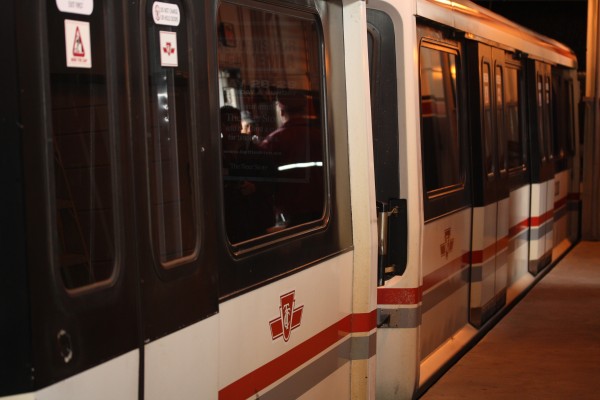

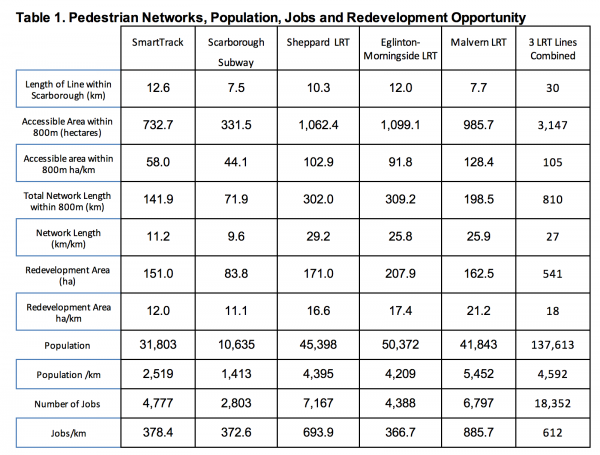
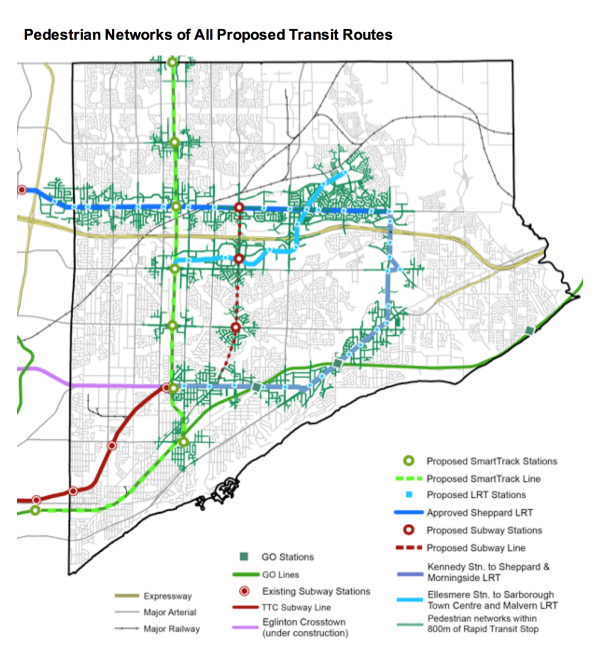
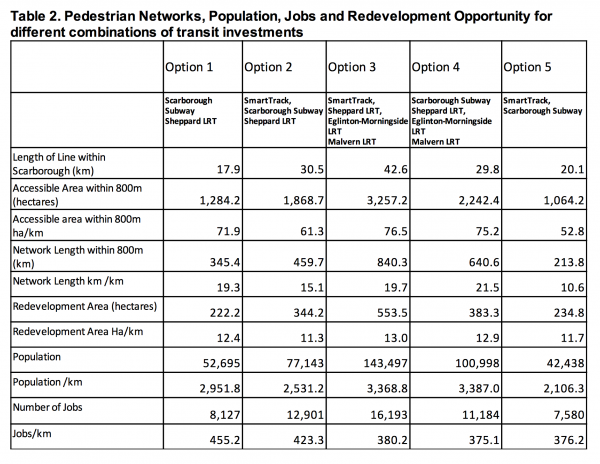
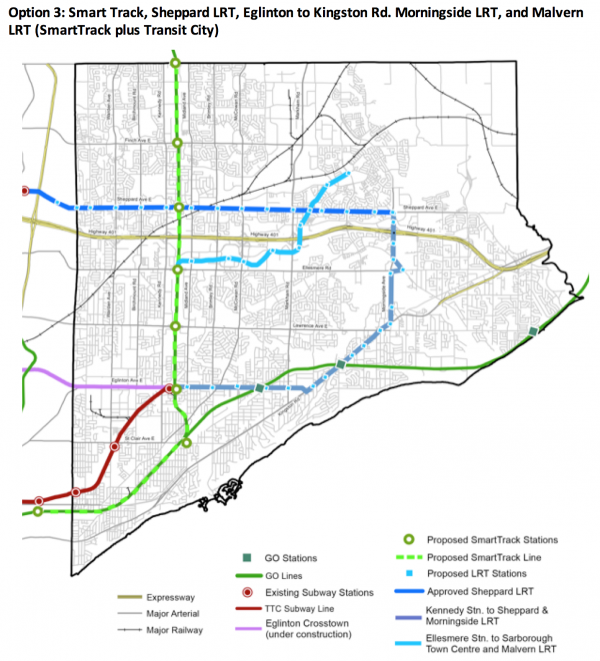
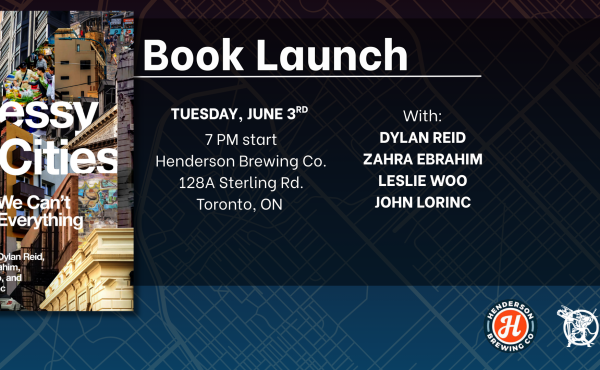


12 comments
It’s so sad, before Rob Ford sank Transit City, Scarborough was set to have the most impressive and connected rail network outside of the downtown core. Now it’s getting stuck with an anemic 3-stops and so many are cheering about it.
This makes quite clear the value of a transit *network* over focusing on single lines or extensions. Scarborough can benefit far more from having its own network, and I hope this helps move that conversation forward in the future.
For those curious, here’s the status of the three lines originally described as proposed:
1. Sheppard East LRT: proposed in 2006 as part of Transit City, approved and fully funded by province (construction and overruns, and at least partial operating costs), construction began in 2009, was to open in 2013, but delayed by Premier McGuinty and Mayor Ford. Currently planned to restart construction in 2017, and open in 2020-2021.
2. Eglinton-Malvern LRT: proposed in 2006 as part of Transit City, but considered lower priority so was never approved or funded. Only proposed line (subway or LRT) to serve southern Scarborough.
3. Scarborough LRT: approved and fully funded by province (from Kennedy Stn to Sheppard and Progress, phase 2 north of Sheppard not funded). Was originally planned to be complete by this year’s PanAm Games, but delayed for provincial budget reasons, then cancelled by city council and province in 2013 for more expensive, shorter subway extension. The subway extension will open later and raise city taxes significantly, but is more popular at this time. Cancellation will cost the city a minimum of $75 million dollars in sunk costs.
To learn more about the specific LRT routes you can read the original environmental assessments (EA’s) at the CodeRedTO site: http://coderedto.com/resources/
It should be noted that in Option 3 above (the one calculated to have the most benefits), there is no longer a direct transit connection between Scarborough Centre and the Bloor-Danforth subway. Instead, riders would have an additional transfer at SmartTrack stations before they got to the subway.
So, the LRT option that was originally planned and has most been discussed as an alternative to the subway extension (i.e. a direct replacement of the current Scarborough RT) is not in any of these options, because part of it directly overlaps with SmartTrack’s route.
John,
I’m reminded of Apple’s legal appeal of US Federal Court Judge Denise Coté’s “eBook” antitrust ruling against Apple:
“Cote, who has a history of pre-judging such trials and then reshaping the legal justifications to fit the foregone conclusion…”
Read more, and see the cartoon mocking the Judge here: : http://www.macnn.com/articles/15/03/10/company.complains.that.antitrust.monitor.overreaches.abuses.position/#ixzz3U5Eo6umm
It’s fine, none of this stuff is getting built anyway, SmartTrack or the Stubway. We’re just going to waste millions on studies, then in 3.5 years we’ll re-elect Rob Ford, or Doug Ford, or Randy Ford, or Mikey Ford – it doesn’t really matter – and everything will get ripped up again and we’ll burn another $85mil for Metrolinx spent time and council will bicker and the people of Scarborough, North York and Etobicoke will get exactly what they deserve (nothing) for sending these incompetent losers to represent them.
This is excellent work; as seems to be the Sorensen and Hess examination of minor details like the overall benefits to costs. But both the province and the majority of the Council (which I now at times call Clowncil from being in the Chamber and enduring this Extension approval debate), seem quite disdainful of mere facts of excess and benefits. Sigh. But in the Layton style of being propositional, I’ve been urging a busway (to start) on the Gatineau Hydro corridor which slices through most of Scarborough to offer diagonal speed, and complementing the geographical constraints of the Lake, and could be done quickly if it was mostly all-surface. Connecting up to the City core could be done by either ensuring space for a busway on the Don Valley Excessway or linkages via Thorncliffe to St. Clair Ave. E. It could thus also begin to be a real Relief Line and be done far far faster than many other things. The disadvantage of using clean buses for transit is that it doesn’t provide nearly the same degree of work for machines and men, and doesn’t use up as much Niagara Escarpment. But we get to squeeze the billions and have faster-done transit.
(Another quick-start is improving linkages between Main TTC and Danforth GO; I’m sure there are some older studies around somewhere)
@Dylan Reid At the same time, most people will chose to stay on Smarttrack and continue downtown, as the majority of trips on the Bloor line end up transferring to the Yonge line downtown.
So for people travelling downtown from STC, there will actually be less transfers.
Now: Transfer from RT to Bloor line. Transfer from Bloor line to Yonge line: 2 transfers.
Option 3: Transfer from Scarborough LRT to Smarttrack at Ellesmere. Take Smarrtrack to Downtown. 1 Transfer.
If the Scarborough LRT were to continue all the way to Kennedy along the current routing, would putting mid-block stations to better serve the community be an option? Sure it’d add to the cost of the project, but it would increase the usability and coverage of the line and the potential benefits for redevelopment and intensification along Kennedy.
It is so sad to see critical thinking not being used today.
There is a lot more to planning transit routes than just how many people are within walking distance.
Of course an LRT (the routes proposed for Toronto are really just streetcar lines, as they will stop so often and not provide rapid transit) is going to have more people within walking distance, when it is a local service operating down the street like the bus route it would replace.
The subway on the other hand does not rely only on walk up customers. And it troubles me that people in Toronto, the city which is a world leader in bus, streetcar, subway connections, have seem to have lost that knowledge. Toronto’s subway is not the success it is, because everyone walks to the stations. It is a success, because the majority of people take a bus to the station, greatly expanding the reach of the subway system. This is why Toronto’s subway carries vastly more people than other systems in North America.
When it comes to Scarborough, it really does not matter how many people are within walking distance, because most will be coming in by feeder bus. Toronto has plenty of stations in lower density areas that have higher ridership numbers than stations in high density areas. And it all has to do with our outstanding feeder bus network.
Just because a line has more people within walking distance (LRT) does not mean it is the better option. It is also not the better option, when said line will carry less people than the subway line which has less people within walking distance. Why will the subway carry more people? Because the feeder bus and subway combined offer faster travel times than having more people within walking distance of an LRT which will be almost as slow as the local bus it replaces.
We really need to start actually looking at the facts and stop following the transit fads of the day, be it BRT, LRT, or even subways in some cases. Stop following fads, and start building a rapid transit network that will move the most people around.
I wonder if Sorensen and Hess considered comparing the costs of Phase 2 of Transit City in Scarborough to the Stubway! Ed Keenan did in one of his columns & pointed out “Reallocating that full Scarborough stubway budget, you could build a whole network of LRT lines that have been proposed in Scarborough: extend the Scarborough RT replacement line out to Malvern, extend the Sheppard LRT line out to the zoo, and build the once-proposed 20-stop Scarborough-Malvern LRT along Eglinton and Kingston Road and past the U of T Scarborough campus.” Keenan
http://www.thestar.com/news/gta/2015/01/28/not-too-late-to-really-talk-transit-in-scarborough-keenan.html
This paper makes three major mistakes, and those mistakes largely invalidate its conclusions.
1) The authors propose a new version of the trunk LRT line in Scarborough (they call it “Malvern LRT”, that would run from the Ellesmere SmartTrack station to STC and then to Malvern. Thus, STC will no longer have a direct connection to Bloor-Danforth subway, and a lot of riders will be brought to SmartTrack instead.
However, the authors offer no proof that SmartTrack will be capable of handling so many passengers from STC, in addition to those coming from Markham and the north of Scarborough. Note that the frequency and train size for SmartTrack is not known at this point.
If SmartTrack cannot handle that load, then the majority of this paper’s conclusions do not hold.
2) The paper excludes 75% of Scarborough residents from its benefit analysis. The largest number of residents within the “accessible area” in any of their options is 143,500; while the total population of Scarborough is more than 600,000.
Many of residents not living in the “accessible area” will benefit more from SmartTrack and Scarborough Subway than from LRTs. Those people will have to take a bus in any case, but after that, they will prefer to transfer to a faster high-order transit.
Some weight in the modeling should be given to those residents and their interests. However, this factor is totally ignored in the paper.
3) The paper repeatedly compares the full LRT network to the options where subway is included, but 2 or all 3 LRT lines are absent. It assumes that the subway, if built, will replace 2 or all 3 LRT lines.
Such assumption is plain wrong for Sheppard LRT (which is already funded, and its funding is independent on Scarborough Subway), and is debatable for “Eglinton-Morningside LRT”. The latter is not funded at present, and in theory the funding allocated for subway could be re-purposed to build that LRT. But in practice, the funds are more likely to be lost for transit altogether if the subway is cancelled.
As a result, the paper fails to make the most relevant comparison: (SmartTrack + 3 LRT lines; this is their Option 3) versus (SmartTrack + subway + 2 LRT lines; they do not consider this option at all).
While I don’t disagree with the conclusion the analysis is grossly inaccurate. The proposed subway will service far mor than 2900 jobs. Scarborough General Hospital supports more than 5000 employees. I imagine the SCT would have even more and how many jobs exist at McCown and Sheppard?
This blatant skewing of the data discredits the whole analysis. I find this ironic considering the intro was about the due diligence the private sector invests in this type of analysis.